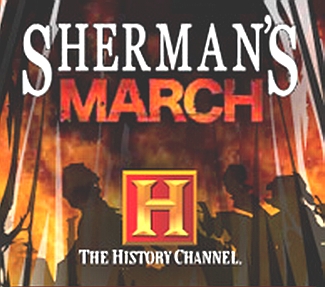Sherman's March (2007 film) facts for kids
Quick facts for kids Sherman's March |
|
|---|---|

Publicity image
|
|
| Written by | Rick King |
| Directed by | Rick King |
| Starring | Bill Oberst Jr. |
| Narrated by | Edward Herrmann |
| Theme music composer | Mark Adler |
| Country of origin | United States |
| Original language(s) | English |
| Production | |
| Producer(s) | Lori Gibson |
| Cinematography | Rob Lyall |
| Editor(s) | Mickey Green |
| Running time | 100 minutes |
| Release | |
| Original network | History Channel |
| Original release | April 22, 2007 |
Sherman's March is a 2007 TV movie, also called a docudrama. It first showed on the History Channel. The film tells the story of a famous event from the American Civil War. This event was called the "March to the Sea". It was a long journey by the Union Army, led by General William Tecumseh Sherman. The movie also covers the Campaign of the Carolinas, which helped end the war. Rick King directed the film, and Edward Herrmann was the narrator. Sherman's march became a big symbol of how destructive the Civil War was. The film asks a big question: Was Sherman a "terrorist" or a "savior"?
The Story of the March
This documentary shows General William Tecumseh Sherman's famous "March to the Sea". This march happened through Georgia, South Carolina, and North Carolina in late 1864. Sherman led 62,000 Union soldiers over 650 miles. They did this in less than 100 days. Amazingly, they only lost about 600 men during this huge journey.
The march brought a new idea to the Civil War: total war. This means that the difference between soldiers and regular people became unclear. Sherman's actions were seen differently by different groups. White Southerners hated him because he caused so much destruction. But Black Southerners saw him as a liberator, someone who set them free.
The film uses modern movie techniques to tell the story. It has CGI, special effects, and historical re-creations. Actors play Sherman's soldiers and speak lines taken directly from real historical writings. These include letters, Sherman's own memories, and diaries from that time. The documentary also looks at Sherman's personality. It mentions that before the Civil War, some people thought he was unwell.
Bill Oberst, Jr., the actor who plays Sherman, said something interesting. He hoped the movie would help people understand why Sherman did what he did. Sherman will always be a debated figure. The film shows that enslaved Black people loved Sherman because he freed them. Even though Sherman didn't see himself as fighting to end slavery, he treated Black people he met with kindness. The movie also shows how Sherman's soldiers reacted to meeting Black people. Many had never seen a Black person before. They were surprised to learn that Black people were just ordinary people.
The documentary also points out that Sherman caused fewer deaths than his friend, General Ulysses S. Grant. Yet, Sherman was the one who was often criticized. Historians in the film suggest that the South needed someone to blame after the war. Sherman became an easy target. For his part, Sherman was said to believe he was just doing his duty. He didn't care what people said about him.
Who Played Who?
Here are some of the main actors and who they played in the film:
- Bill Oberst Jr. as General William Tecumseh Sherman
- Jared Morrison as Major Henry Hitchcock
- Chris Clawson as Theodore Upson
- Mike Brown as General Oliver O. Howard
- Allen Brenner as Brigadier General Jefferson C. Davis
- Harry Bulkeley as General Ulysses S. Grant
- Shaun C. Grenan as Confederate Officer, Union soldier
- Robert A. Guadagnino as soldier
- Lucas N. Hall as 1st Lieutenant C.S.A.
- Russell Haynes as soldier
- Marc A. Hermann as Sherman's bummer, US Artillerist, CS Soldier
- Eric U. Lowman as executioner, Western Zouave
- Todd McCall as General Sherman's Staff Officer
- Joan Moses as Dolly Burge
- Gavin Peretti as executed man
- Norman J. Pfizenmayer III as soldier
- A.J. Roberts as General Judson Kilpatrick
- Jeffrey F. Smith as General Joseph E. Johnston
- Timothy Smith as Union soldier
- Keith E. Whitehead as Griswoldville soldier
- Brad Wyand as soldier
Other cast
- Guy W. Gane III as Major Rhoads
- Bob Waters as leader of escaping slaves, Ebenezer Creek
- Scott E. Zeiss as Chaplain John Height
- Victoria Cooper as Emma LeConte
History Experts
The film also got help from these history experts:
- John F. Marszalek - Historian, Mississippi State University
- Stephen Davis - Civil War historian
- Gordon Jones - Military historian, Atlanta History Center
How the Film Was Made
The movie was filmed in several real locations. These included Washington County, Maryland. They also filmed at Endview Plantation and Lee Hall in Newport News, Virginia. Some scenes were also shot in Gettysburg, Pennsylvania. The filming was done in High Definition, which means it looks very clear and detailed.

